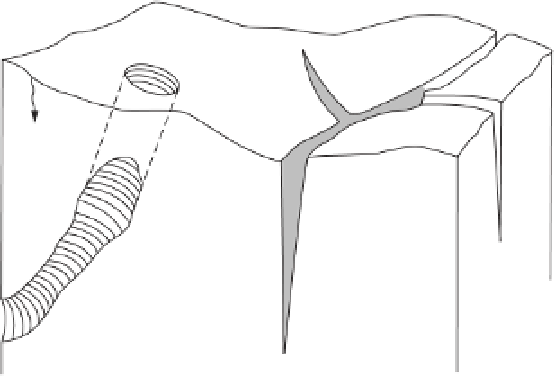Environmental Engineering Reference
In-Depth Information
density might reduce water storage because of enhanced
drainage and because of water loss due to plant uptake, but
these effects might be offset by higher rates of infiltration
into those areas where most roots are found (thus increas-
ing the time-averaged soil wetness around the roots).
The emphasis on plants and vegetation thus far has
been deliberate - it is evident that plants do affect hills-
lope hydrological processes and, in turn, are affected by
them - but ecohydrological patterns can occur through
other means. Charles Darwin is almost universally known
for
On the Origin of Species by Means of Natural Selection
published in 1859. Fewer are aware of his work pub-
lished 22 years later titled
The Formation of Vegetable
Mould Through the Action of Worms
(Darwin, 1881). In
the latter he describes his own research and that of his
sons and others on the 'habits' of earthworms and their
role as geomorphological and hydrological agents. In the
concluding chapter of the worms topic he notes:
'Rain-water, oozing down the burrows would also carry
fine dark-coloured particles into every crevice' (p. 211).
But, he also notes that worms may line their burrows
with material excreted by them, such that the burrows
are akin to being lined with cement (p. 112), and that
'When gardeners wish to kill worms on a lawn, it is
necessary first to brush or rake away the castings from
the surface, in order that the lime-water may enter the
burrows' (pp. 61-2).
The canonical macropore diagram of Beven and Ger-
mann (1982) was published 101 years later (Figure 10.4),
which shows what appears to be an earthworm burrow
acting as a conduit for surface water to the deep-
est parts of the soil profile. The diagram also shows
water flowing through the burrow wall into the finer
soil matrix. Beven and Germann (1982) are rightly
cautious about the hydrological role of macropores in
soils; they note that 'A lot more experimental work is
required to specify the conditions under which macro-
pore flow is important
...
' Despite such caution, it is
often assumed that all macropores are hydrologically
important - that the canonical macropore diagram is a
universal hydrological truth - which, as Darwin's descrip-
tions show, is a naıve view; earthworm burrows may be
hydrologically insignificant if their tops are clogged with
castings, or if their 'cement' linings are impermeable. In
addition, it has been shown that some species of earth-
worm are compacting (their activities cause increases
It is believed by some persons that worm-burrows, which
often penetrate the ground almost perpendicularly to a
depth of 5 or 6 feet, materially aid its drainage; notwith-
standing that the viscid castings piled over the mouths
of the burrows prevent or check the rain-water directly
entering them. (p. 311)
Elsewhere, he notes: 'After heavy rain succeeding dry
weather, an astonishing number of dead worms may
sometimes be seen lying on the ground' (p. 14) and
P(t)
S1(t)
S1(t)
Macropore
S1(t)
O(t)
I1(t)
I1(t)
I2(t)
I2(t)
Figure 10.4
The canonical macropore
diagram (Modified with permission from
Beven, K. and German, P. (1982)
Macropores and water flow in soils.
Water Resources Research
, 18, 1311-25).
Macropore
Soil Matrix


























Search WWH ::

Custom Search